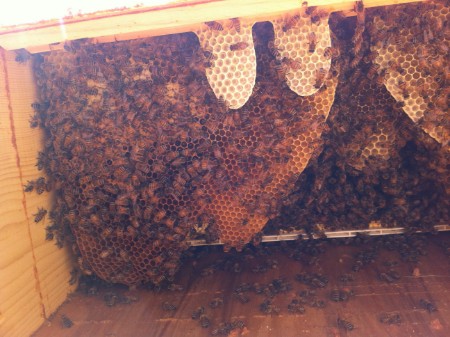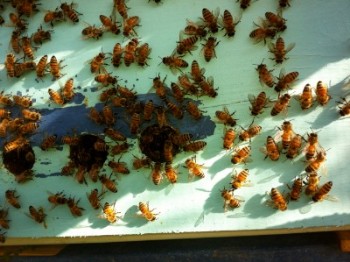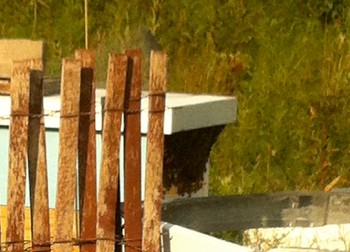
Building a straight-sided top bar
Materials list
- 12 feet of 2x12, for 2 48" sides, and 2 23" fronts.
- 22" x 48" of luon for the bottom.
- A 18" by 12" patch of screen.
- 35 bars at 21 3/8" long, 1 3/8" wide, thickness at least 0.5 inches. Slats for plaster and lath can work, or you can rip 5 looooong bars from a 2x4x8. That's 20 bars.
- 35 lengths of 16" of inside corner molding, for the comb guide.
- A 24" x 52" piece of plywood, with 4" sides, for the lid.
- Roofing paint for the lid.
- Latex paint for the wood, especially the exposed ends.
- Some kind of base, ideally with smooth straight legs so mice won't be a problem.


Hive body
The box sides are all made of 2 x 12 lumber, because I worried that the 1 x would potentially warp to a degree along the middle. I'm glad I chose to use 2 x... It is solid (and I need that when moving empty hives around, since I have to walk it on its corners!); and it is great natural insulation. I have noticed a small amount of warping, mainly with the bee-tight divider, more on that later.
The inside width and height of the box match those of a Langstroth, from the Langstroth rabbet down to the bottom of the box, NOT from the top of the Langstroth box. So a Langstrogh frame fits, as long as the bottom is clear; there is more clearance in a double deep from frame bottom to the frame top below. I can't make the boxes deeper because the bees will make the comb deeper - and then I can't put the comb in a Langstroth box. I can put a 1/8 to 1/4" piece of wood below the Langstroth frame ear...
The length of the box is 42" in the majority of models here on the farm - that way one sheet of plywood can make 4 lids. But I recommend 48" long boxes, which would theoretically fit 35 bars if they are all 1 3/8". With a 42" long box (which nominally fits 30 bars), I can only fit about 26 - remember, that is the equivalent of 2 deep boxes (20 frames) and almost 1 medium super (10 medium frames). Because the bees sometimes draw comb fatter than the bar, it is easier to use a spacer between bars to allow for wider combs than to cut every comb narrower (do not do this in the hive ever, thank you school of hard knocks), or to just mash combs together (didn't need the school of hard knocks to tell me that was a bad idea).
Luon bottom with screen bottom
In my area, mites can kill a first year hive that was split mid-season; and if they don't kill the hive that year, it never thrives enough to store honey the following year. See mite control in a top bar hive for more about that. I have used OAV successfully to keep mite levels low. I have used a 1.25" hole where I could push the wand up against the bottom of the hive. I had a silicon fitting that went over the lip of the wand, to keep the luon from getting too hot...A lot of oxalic acid vapor leaks out and will flow over you. There is no down-wind. Your life is dependent on your safety equipment. SO, I don't recommend this method. pic under hive, wand?
I now have screened bottoms that are about 12" along the bottom of the hive, and they have slide-in trays. The screen must be pretty flush with the bottom - if it sticks up, combs will get caught, and if it is sunk below by more than 1/8", the bees may draw comb too deep for the rest of the hive. Access to the removeable tray is through the front of the hive. I keep those in year round. There is enough space for the OAV wand to sit on the removeable tray and be just under the screen. pic of screened bottom. This was tricky for my perfectionist husband to build. We used a frame setup,
which allowed for a metal piece to be slid in as a bottom for the screen. I would have stapled screen to the hole and hoped
for the best, but to me perfect is the enemy of done.
Bars for the comb
We use bars that are 21 3/8" long, which go exactly (mostly) to the edge of the box. They are 1 3/8 wide, which the bees love for brood comb. I have found when I put an empty bar between drawn bars, the bees sometimes draw the honey portion fat instead of doing anything with the empty bar. Sigh. I use 1/4" spacers (of miscellaneous height, but same length) for keeping bee space, rather than trimming honey-laden comb (just don't, trust me) or mashing bars together (has never seemed like a good idea).
The bars have about 16" of inside corner molding nailed as a comb guide. This dimension is not critical, but should allow for 1" between the end of the comb guide and the inner wall. The bees treat the comb guide as a gentle suggestion. We tried using the table saw to cut a bar with angled sides so we did not need to add a comb guide... and one emergency room trip later, my husband can only count to 9.9 instead of 10. So we decided that attaching a comb
guide to a flat bar as a separate operation was the smart way to go.




